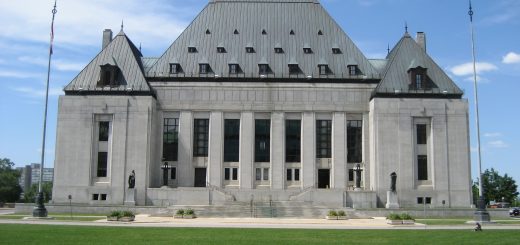West Fraser Mills Ltd. v BC (Workers’ Compensation Appeal Tribunal) : Recognizing the Complexities of Workplace Safety

Courts have forever grappled with defining the legal scope of liability between various parties in society. The Supreme Court of Canada (“SCC” or the “Court”) released a decision in West Fraser Mills Ltd v BC (Workers’ Compensation Appeal Tribunal), 2018 SCC 22 [West Fraser], which upheld a claim of workers compensation against a non-employer. This case made its way to the highest court on the question of whether or not the administrative tribunal involved—the British Columbia’s Workers’ Compensation Board—could hold a forestry company legally responsible for a workplace accident involving an employee of the company’s independent contractor. Given the upcoming administrative law review of Dunsmuir by the SCC, this post will avoid the discussion surrounding the applicable standard of review for the tribunals’ decisions and instead focus on the employment liability issues.
Background
The facts leading to this case are tragic. A tree faller, who was employed by an independent contractor to help clear a forest in British Columbia (“BC”), was killed when he was struck by a rotting tree in the course of his employment. The license to harvest the area of the forest where the tree faller died was held by a company called West Fraser Mills Ltd. (“West Fraser Mills”). As such, there was no employment relationship between the deceased and West Fraser Mills.
The Workers’ Compensation Board (“Board”) conducted an investigation of the accident and held that West Fraser Mills was in violation of s. 26.2 (1) of the Occupational Health and Safety Regulation, BC Reg 296/97 [Regulations], which states,
The owner of a forestry operation must ensure that all activities of the forestry operation are both planned and conducted in a manner consistent with this Regulation and with safe work practices acceptable to the Board.
For failing to abide by these regulatory requirements, the Board acted on its statutory power to impose sanctions on employers, and fined West Fraser Mills $75,000 as an administrative penalty. It did so pursuant to s. 196(1) of the Workers Compensation Act, RSBC 1996, c 492 [WCA], which permits the Board to impose penalties on employers if the Board is satisfied on a balance of probabilities that,
- the employer has failed to take sufficient precautions for the prevention of work related injuries or illnesses,
- the employer has not complied with this Part, the regulations or an applicable order, or
- the employer’s workplace or working conditions are not safe.
The Workers’ Compensation Appeal Tribunal upheld the decision in principle, but lowered the amount of the administrative penalty. Subsequent appeals by West Fraser Mills were unsuccessful.
The case landed at the SCC, where two major issues arose. The first issue considered whether the Board had jurisdiction to promulgate regulations sanctioning the activities of non-employers. The second issue considered whether, even if s. 26.2 of the Regulations was intra vires, the Board misapplied s. 196(1) of the WCA by penalizing the owners of the forestry license.
Although the Court was split 6-3, with each dissenting Justice writing a separate opinion, Justice McLachlin upheld the Board’s decision on behalf of the majority.
The Majority Decision
Section 26.2(1) of the Regulations is not Ultra Vires
The majority’s decision began by pointing out the statutory authority for the Board to enact regulations. S. 225 of the WCA empowers the Board to “make regulations [it] considers necessary or advisable in relation to occupational health and safety and occupational environment” (West Fraser, para 6). As mentioned earlier, the Board, pursuant to s.225, adopted s. 26.2 of the Regulations, imposing a duty on owners of forestry operations to conduct these operations in a safe manner
Deriving her authority from Dunsmuir v New Brunswick, 2008 SCC 9, Justice McLachlin conducted a contextual analysis that investigated the legislative intent behind s. 225 of the WCA. She concluded that by giving the Board the power to make regulations that were “necessary or advisable” to promote workplace safety, the legislature essentially wanted the Board to enact “whatever regulations it deemed necessary to accomplish its goals of workplace health and safety. [Consequently] [t]he delegation of power to the Board could not be broader” (para 10).
Given the Board’s broad authority, the majority ruled that the Board was well within its power to enact rules that regulated the activity of owners of forestry operations, even if they were not direct employers in a project. Justice McLachlin parsed through the WCA to support the majority’s position by finding other sections within the statute that permit the Board to make regulations applying to any “persons working in or contributing to the production of an industry” or generally aim to promote occupational safety as broadly as possible (para 14). According to the majority, the Board was well within its jurisdiction to adopt a regulation that imposes a duty upon the owners to ensure safe employment practices.
Interpreting s. 196(1) of the WCA
Although s. 196(1) explicitly states that the Board may impose penalty on employers the majority still sanctioned the decision to penalize the owners of the forestry operation, West Fraser Mills. Both of these terms are defined in the WCA, but the majority decided that the term “employer” in the context of s. 196(1) is broad enough to reasonably include the license holder of the harvest area.
West Fraser Ltd submitted that because the terms “employer” and “owner” are explicitly defined in the WCA under ss. 115 and 119, they could not be used interchangeably when interpreting s. 196(1). Furthermore, the appellants argued that a close look at the WCA demonstrates separate provisions that exclusively apply to “employers” only, while others are broader in nature and apply to a “person” in the sense of ‘anyone’. (WCA, ss. 194, 195 and 198).
Justice McLachlin considered these submissions, but dismissed them by providing an alternative interpretation of s. 196(1) of the WCA. She stated that although West Fraser Ltd. was not strictly the employer of the victim, it still had statutory and regulatory responsibilities with respect to the worksite that it could only fulfill as an employer. This relationship with the worksite where the accident occurred was a sufficient nexus to bring West Fraser into the scope of the regulations and to penalize the company as an employer with the meaning of s. 196(1) of the WCA. In the majority’s opinion, this broad interpretation of the provision “best furthers the statutory goal of promoting workplace health and safety and deterring future accidents” (para 43).
Justice McLachlin concluded that the Board’s decision was reasonable and should not be overturned. By conducting a contextual analysis, the Court recognized that workplace safety is a complex exercise that incorporates many moving parts. The traditional relationship between an employer and employee is no longer as static as it once was. The goal of promoting workplace safety is greater than technical limitations, and responsibility can be shared beyond the immediate employer.
Dissenting Opinions
Justices Cotê, Rowe, and Brown did not agree with the majority’s approach and each wrote dissenting opinions. Justice Cotê in particular took a very strong position against what she deemed the majority’s conflation between “owners” and “employers” (para 97). She suggested that a plain reading of WCA clearly demonstrates that “owners” and “employers” are separately designated categories, and the category of “employer” does not encompass that of “owners” (para 99). She also suggested that the specification in s. 196(1) of applying penalties to “employers” implies, by negative implication, that no other category of individual can be similarly penalized – which is exactly what the Board did (para 100). In a very direct critique of the majority’s reasoning, Justice Cotê demonstrates a more narrow approach and stated
The fact that West Fraser is an employer in the province, or even at this workplace — although not the employer of the faller who died — does not advance the Tribunal’s position. West Fraser stood accused of breaching its obligations as an owner under s. 26.2(1) of the Regulation. The Tribunal…adopted an unbounded interpretation — one that is “openly, clearly, evidently unreasonable” because it fails to establish any nexus between the underlying breach (of West Fraser’s obligations as an owner under s. 26.2(1)) and the applicability of the administrative penalty (para 104).
The majority of the dissenting opinions focussed on the issue of the appropriate standard of review—a debate that most readers would hope is resolved in the near future with the upcoming standard of review trilogy decision.
Conclusion
This case demonstrates the power of statutory interpretation and the differing conclusions that such an exercise can produce. By focusing on the legislative intent and the basic principles of statutory interpretation, the majority arrived at a conclusion that avoided the standard of review gymnastics that have plagued many administrative law decisions in recent years. As such, they were able to arrive at a progressive decision that recognizes the complexity of workplace safety and confirmed the broad powers of the Workers’ Compensation Board to hold even more distant parties responsible for workplace accidents.







Join the conversation